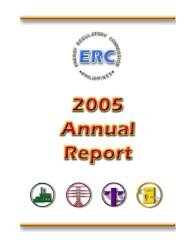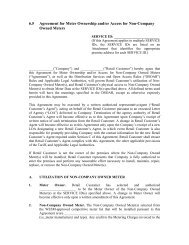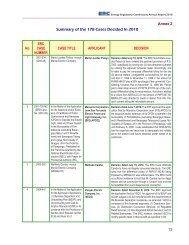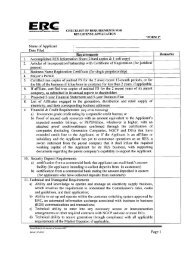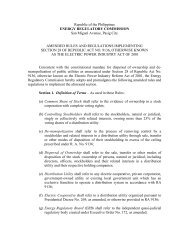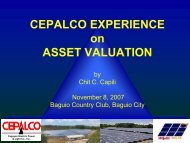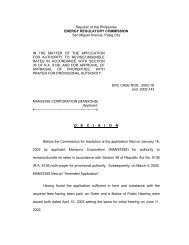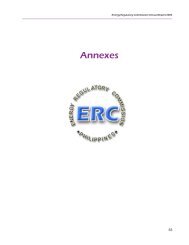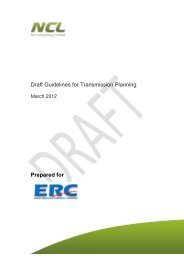ERC Case No. 2001-896 - Energy Regulatory Commission
ERC Case No. 2001-896 - Energy Regulatory Commission
ERC Case No. 2001-896 - Energy Regulatory Commission
You also want an ePaper? Increase the reach of your titles
YUMPU automatically turns print PDFs into web optimized ePapers that Google loves.
Republic of the PhilippinesENERGY REGULATORY COMMISSIONSan Miguel Avenue, Pasig CityIN THE MATTER OF THE APPLICATION <strong>ERC</strong> CASE NO. 2002-11FOR APPROVAL OF THE REVISED RATE (<strong>2001</strong>-<strong>896</strong>)SCHEDULES IN COMPLIANCE WITH SEC.36OF REPUBLIC ACT NO. 9136 AND <strong>ERC</strong>ORDER DATED OCTOBER 30, <strong>2001</strong>, WITHPRAYER FOR PROVISIONAL AUTHORITY.- and –APPLICATION FOR AUTHORITY TO ADJUST <strong>ERC</strong> CASE NO. <strong>2001</strong>-482ITS RATES TO ATTAIN THE ALLOWABLE (ERB CASE NO. 98-75)RATE OF RETURN ON RATE BASE (RORB)WITH PRAYER FOR PROVISIONAL AUTHORITY.CABANATUAN ELECTRIC CORPORATION(CELCOR),Applicant.x - - - - - - - - - - - - - - - - - - - - - - - - - - - - - - - - -xD E C I S I O NBefore the <strong>Commission</strong> for resolution are the consolidated applications filedby applicant Cabanatuan Electric Corporation (CELCOR) for: (a) authority toadjust rates to attain the allowable Rate of Return on Rate Base with prayer forprovisional authority filed on October 26, 1998 and docketed as <strong>ERC</strong> <strong>Case</strong> <strong>No</strong>.<strong>2001</strong>-482 (ERB <strong>Case</strong> <strong>No</strong>. 98-75); and (b) revision of rate schedules in compliancewith Section 36 of Republic Act <strong>No</strong>. 9136, with prayer for provisional authority filedon December 26, <strong>2001</strong> and docketed as <strong>ERC</strong> <strong>Case</strong> <strong>No</strong>. <strong>2001</strong>-<strong>896</strong>. A supplemental
application was filed on January 15, 2002 and docketed as <strong>ERC</strong> <strong>Case</strong> <strong>No</strong>. 2002-11.<strong>ERC</strong> CASE NO. <strong>2001</strong>-482 (ERB <strong>Case</strong> <strong>No</strong>. 98-75)On October 26, 1998, CELCOR filed an application for authority to adjustits rates to attain the allowable Rate of Return on Rate Base (RORB) with prayerfor provisional authority.Having found the said application sufficient in form and substance with therequired fees having been paid, an Order and a <strong>No</strong>tice of Public Hearing, bothdated <strong>No</strong>vember 4, 1998, were issued setting the application for hearing onDecember 8 and 9, 1998.In the same Order, CELCOR was directed to cause the publication of the<strong>No</strong>tice of Public Hearing at its own expense, twice (2x) in two (2) newspapers ofgeneral circulation in the Philippines, which should include one (1) newspaper oflocal circulation within CELCOR’s franchise area, if there be any, the last day ofpublication to be made not later than two (2) weeks before the scheduled date ofinitial hearing.The Office of the Solicitor General (OSG), the <strong>Commission</strong> on Audit (COA)and the Committees on <strong>Energy</strong> of both Houses of Congress were furnished withcopies of the application, the Order and the <strong>No</strong>tice of Public Hearing and wererequested to have their respective duly authorized representatives present at theaforesaid hearing.Page 2 of 46
Likewise, the Mayor of Cabanatuan City was furnished with copies of theOrder and the <strong>No</strong>tice of Public Hearing for the appropriate posting thereof on itsbulletin board.At the December 8, 1998 initial hearing, only CELCOR appeared. <strong>No</strong>oppositors appeared nor was there any opposition registered.CELCOR then presented its compliance with the posting and publication ofnotice requirements and had these marked as Exhibits “A” to “C”, inclusive.Thereafter, CELCOR presented its witnesses, Ms. Adoracion Yatco, CELCOR’sGeneral Manager and Engr. Cesar Elmer V. Sta. Romana, CELCOR’s AssistantGeneral Manager for Operations, for direct examinations. Ms. Yatco testified onthe financial aspect of the application while Engr. Sta. Romana testified on thetechnical aspect of the application. In the course thereof, documents werepresented and marked as Exhibits “D” to “O”, inclusive.During the December 9, 1998 hearing of this case, CELCOR presented itslast witness, Mr. Dante C. Olmo, a Certified Public Accountant, for directexamination. He testified on the audit he conducted on CELCOR’s books ofaccount. In the course thereof, documents were presented and marked as Exhibits“P” to “U-11”, inclusive.CELCOR then moved that it be given ten (10) days from said date ofhearing within which to submit its formal offer of exhibits. Said motion was granted.Page 3 of 46
On December 22, 1998, CELCOR filed its “Formal Offer of Exhibits”.On September 6, 1999, CELCOR was granted a provisional authority tomake an upward adjustment in its rates by P0.20/kWh with a rate of return on ratebase of 8.67% effective with respect to its September 1999 billing cycle.<strong>ERC</strong> CASE NOS. <strong>2001</strong>-<strong>896</strong> and 2002-11On December 26, <strong>2001</strong>, CELCOR filed an application for approval of itsrevised rate schedules in compliance with Section 36 of Republic Act <strong>No</strong>. 9136,with prayer for provisional authority. Subsequently, on January 15, 2002, it filed asupplemental application.Having found the said application sufficient in form and substance with therequired fees having been paid, an Order and a <strong>No</strong>tice of Public Hearing, bothdated April 9, 2002, were issued setting the application for hearing on May 13,2002.In the same Order, CELCOR was directed to cause the publication of the<strong>No</strong>tice of Public Hearing at its own expense, twice (2x) for two (2) successiveweeks in two (2) newspapers of nationwide circulation in the country, the last dayof publication to be made not later than two (2) weeks before the scheduled dateof initial hearing.The Office of the Solicitor General (OSG), the <strong>Commission</strong> on Audit (COA)and the Committees on <strong>Energy</strong> of both Houses of Congress were furnished withcopies of the application, the Order and the <strong>No</strong>tice of Public Hearing and werePage 4 of 46
equested to have their respective duly authorized representatives present at theaforesaid hearing.Likewise, the Mayor of Cabanatuan City was furnished with copies of theOrder and the <strong>No</strong>tice of Public Hearing for the appropriate posting thereof on itsbulletin board.On May 10, 2002, the Honorable Cong. Aurelio M. Umali filed an “Entry ofAppearance with Omnibus Motion” praying for the suspension of the proceedingsuntil the Supreme Court has ruled on the case questioning the constitutionality ofRepublic Act <strong>No</strong>. 9136 or the cancellation of the presentation of evidence to givehim time to study, review, examine and scrutinize the voluminous documents andrecords submitted by CELCOR.During the May 13, 2002 initial hearing, CELCOR presented its proofs ofcompliance with the <strong>Commission</strong>’s publication and posting of notice requirementsand had these marked as Exhibits “A” to “C”, inclusive. Thereafter, CELCOR’spresentation of witnesses was deferred until after the lapse of the fifteen (15) daysgranted to Cong. Umali to comment on the application. CELCOR was thendirected to furnish said oppositor with copies of its application together with itsattachments.Relative to the omnibus motion filed by Cong. Umali, CELCOR moved thatit be given five (5) days from said date of hearing within which to submit itscomment thereon.Page 5 of 46
On May 20, 2002, CELCOR submitted its “Answer/Comment to OmnibusMotion” stating among others that the provisions being questioned in the casebefore the Supreme Court did not include Section 36 of R.A. 9136 which was thebasis of the instant application so that in the event that R.A. 9136 is declaredunconstitutional, said section would not be affected. It, thus, prayed for the denialof the said motion.During the May 31, 2002 hearing, Cong. Umali moved to have the case setfor pre-hearing as he had not yet filed his opposition. CELCOR objected to thesaid motion and prayed that it be allowed to present its evidence subject towhatever pleadings the Cong. Umali may wish to file. The <strong>Commission</strong> deniedsaid motion.CELCOR presented its only witness, Ms. Pamona Sardillo, CELCOR’sInternal Auditor, who testified on the procedure and methods used to come up withthe unbundling application and comply with the provision of Section 36 of R.A.9136. In the course thereof, documents were presented and marked as Exhibits“D” to “M -1”, inclusive. Cong. Umali reserved his right to cross-examine the saidwitness and file his formal opposition. The <strong>Commission</strong> then propoundedclarificatory questions on the said witness. In the course thereof, CELCOR wasdirected to submit various documents.In the meantime, in the Order dated June 4, 2002, the <strong>Commission</strong> deniedthe omnibus motion filed by Cong. Umali, for lack of merit.Page 6 of 46
During the July 16, 2002 hearing, CELCOR recalled its witness, Ms.Sardillo, to testify on the submissions made pursuant to the <strong>Commission</strong>’sdirective in its Order dated June 4, 2002. Thereafter, Cong. Umali, throughcounsel, conducted his cross-examination of the said witness.During the October 11, 2002 hearing, Cong. Umali, through counsel,continued with his cross-examination of Ms. Sardillo. He then informed the<strong>Commission</strong> that he would file a motion for reconsideration of the denial by the<strong>Commission</strong> of the introduction of a document from the Securites and Exchange<strong>Commission</strong> (SEC) which was not presented during the direct examination of thesaid witness.On October 29, 2002, the <strong>Commission</strong> directed Cong. Umali to submit theaforementioned motion for reconsideration with a warning that his failure to file thesame would mean a waiver of his right to do so.During the February 7, 2003 hearing, only CELCOR and its witnessappeared and manifested that Cong. Umali’s right to cross-examine its witnessshould be deemed waived. Said manifestation was duly noted. The <strong>Commission</strong>then propounded clarificatory questions on CELCOR’s witness, Ms. Sardillo. In thecourse thereof, CELCOR was directed to submit various documents. CELCORfurther manifested that it would file a copy of its Amended Articles of Incorporationas approved by the SEC.Page 7 of 46
CELCOR then moved that it be given ten (10) days from said date ofhearing within which to submit its formal offer of exhibits. Said motion was granted.On February 10, 2003, Cong. Umali was directed to present his evidenceon March 13, 2003 hearing with a warning that his failure would mean a waiver ofhis right to do so.On February 17, 2003, CELCOR filed its formal offer of exhibits.On even date, an Order was issued by the <strong>Commission</strong> consolidating <strong>ERC</strong><strong>Case</strong> <strong>No</strong>. <strong>2001</strong>-482 (ERB <strong>Case</strong> <strong>No</strong>. 98-75) with <strong>ERC</strong> <strong>Case</strong> <strong>No</strong>. 2002-11.During the March 13, 2003 hearing, only CELCOR appeared and movedthat Cong. Umali be declared to have waived his right to present his evidence.Said motion was granted. Thus, the case was deemed submitted for resolution.I. SUMMARY OF CELCOR’s APPLICATIONI.A. REVENUE REQUIREMENTSCELCOR proposes an adjusted revenue requirement of PhP630,459,144based on the historical test year as evidenced by its submitted Overall AverageTariff Adjustment (OATA) to increase its rates by PhP0.4661/kWh as shownbelow, to wit:Page 8 of 46
TABLE 1Adjusted ElectricAccount Name(PhP)Purchased Power 1 434,036,293Payroll 48,362,556O & M (net of Purchased Power andPayroll) 2 75,615,639Depreciation and Amortization 3 19,215,628Income Taxes 4 4,138,426Other ExpensesReturn on Rate Base 5 72,074,407Revenue Requirement 653,442,949Less: CELCOR’s Adjustment 22,983,805Adjusted Revenue Requirement 630,459,144Existing Revenue 574,382,893Required Increase/(Decrease) 56,076,251Required Increase/(Decrease) per kWh 0.4661________________________12345Gross of NPC discounts and inclusive of purchases from FCVCGeneral and Administrative expenses and Customer Information expenses including franchise tax.Depreciation at Cost of P15,076,895 and at appraisal of P4,138,733Actual Income Tax for the year 2000Computed at a WACC of 12.34%I.A.1. OPERATING REVENUESCELCOR reported a total operating revenue of PhP574,382,893, for theyear 2000, computed as follows:TABLE 2Customer TypeRevenue (PhP)Residential Service 248,063,646Small Commercial 62,947,936Large Commercial 131,439,270Very Large Commercial 80,835,877Semi-Industrial 18,141,008Small Industrial 3,282,176Large Industrial 7,204,678Streetlights-Metered 2,026,389Streetlights-Unmetered 3,595,947Hospital 16,845,966TOTAL 574,382,893Page 9 of 46
I.B. RATE BASECELCOR proposed that Schedule B (Restated Value of Assets) be used asbasis in the determination of its Rate Base. Thus, CELCOR utilized the appraisedvalue of its assets as of September 12, 1996 approved by the then Board and wasfurther adjusted to reflect additions, retirements and depreciation for the periodSeptember 13, 1996 to December 31, 2000. The proposed rate base is as follows:TABLE 3Total Company(Electric Only)Distribution Plant PhP 515,799,388General Plant 101,054,468Total Plant in Service PhP 616,853,856Unbundled CWIP 125,298Total PhP 616,979,154Accumulated Depr.Distribution Plant PhP 102,677,269General Plant 20,230,270Total Accum. Depr. PhP 122,907,539Net Plant in Service PhP 494,071,615Other Rate Base Items:Materials & Supplies PhP 5,295,797Cash Working Capital 84,479,884Sub-Total PhP 89,775,681TOTAL RATE BASE PhP 583,847,296I.B.1 Plant in ServiceI.B.1.a Asset ValuationCELCOR’s assets were last appraised by an independent appraiser, AsianAppraisal, for assets in service as of September 12, 1996. Said appraisal wasapproved by the then <strong>Energy</strong> <strong>Regulatory</strong> Board on March 26, 1998 in ERB <strong>Case</strong><strong>No</strong>. 97-17 at an adjusted Sound Value of PhP366,048,243.Page 10 of 46
Small CommercialDistribution ChargeSupply Charge - RetailSupply Charge - MeteringPhP 1.0570/kWh0.3260/kWh0.3565/kWhLarge CommercialDistribution ChargeSupply Charge - RetailSupply Charge - MeteringPhP 0.9435/kWh0.0264/kWh0.0278/kWhVery Large CommercialDistribution ChargeSupply Charge - RetailSupply Charge - MeteringDemand ChargePhP 0.8455/kWh0.0125/kWh0.0051/kWh75.00/kWSmall IndustrialDistribution ChargeSupply Charge - RetailSupply Charge - MeteringDemand ChargePhP 2.7777/kWh0.0221/kWh0.0275/kWh75.00/kWSemi IndustrialDistribution ChargeSupply Charge - RetailSupply Charge - MeteringDemand ChargePhP 0.6367/kWh0.0044/kWh0.0082/kWh75.00/kWLarge IndustrialDistribution ChargeSupply Charge - RetailSupply Charge - MeteringDemand ChargePhP 1.2897/kWh0.2695/kWh0.0059/kWh75.00/kWHospitalsDistribution ChargeSupply Charge - RetailSupply Charge - MeteringDemand ChargePhP 0.6006/kWh0.6329/kWh0.0089/kWh75.00/kWPage 12 of 46
Streetlights - UnmeteredDistribution ChargeSupply Charge - RetailSupply Charge - MeteringPhP 0.9307/kWh0.0016/kWh0.0053/kWhStreetlights-MeteredDistribution ChargeSupply Charge - RetailSupply Charge - MeteringPhP 1.2881/kWh0.3452/kWh0.3773/kWhResidential Distribution Wheeling ServiceDistributionMetering Charge-OptionalPhP 1.1791/kWh0.5380/kWhSmall Commercial Distribution Wheeling Service (Less than or Equal to 15 kW)DistributionMetering Charge-OptionalPhP 1.0570/kWh0.3565/kWhLarge Commercial Distribution Wheeling ServiceDistributionMetering Charge-OptionalPhP 0.9435/kWh0.0278/kWhVery Large Commercial Distribution Wheeling ServiceDistributionMetering Charge-OptionalPhP 0.8455/kWh0.0051/kWhSmall Industrial Distribution Wheeling ServiceDistributionMetering Charge-OptionalPhP 2.7777/kWh0.0275/kWhSemi Industrial Distribution Wheeling ServiceDistributionMetering Charge-OptionalPhP 0.6367/kWh0.0082/kWhPage 13 of 46
Large Industrial Distribution Wheeling ServiceDistributionMetering Charge-OptionalPhP 1.2897/kWh0.0059/kWhHospitals Distribution Wheeling ServiceDistributionMetering Charge-OptionalPhP 0.6006/kWh0.0089/kWhStreetlights-Metered Distribution Wheeling ServiceDistributionMetering Charge-OptionalPhP 1.2881/kWh0.3773/kWhI.D.1. FUNCTIONALIZATION & ALLOCATIONThe functionalization and allocation factors used by CELCOR were thedefault factors provided for in the UFR prescribed by the <strong>Commission</strong>.I.D.2. GENERATION and TRANSMISSION CHARGECELCOR proposed the adoption of a Generation and Transmission Chargefor the following customer classes in order to recover its power cost, franchise tax,system losses and company use, as follows:For Residential and Other Customer Classes without Demand ChargeA 1Generation/Transmission = ------------------------- x ----------Charge B – ( C 1 + C 2 + C 3 ) 1 – FTWhere:A = Cost of electricity purchased from NPC and other sources for theprevious monthB = Total kwh purchased for the previous monthC 1 = Actual system loss for the previous monthC 2 = Actual company use for the previous monthC 3 = Kwh consumed by lifeline customers for the previous monthFT = Franchise tax ratePage 14 of 46
For Industrial and Other Customer Classes with Demand ChargeA - D 1Generation/Transmission = ------------------------- x ----------Charge B – ( C 1 + C 2 + C 3 ) 1 – FTWhere:A = Cost of electricity purchased from NPC and other sources for theprevious monthB = Total kwh purchased for the previous monthC 1 = Actual system loss for the previous monthC 2 = Actual company use for the previous monthC 3 = Kwh consumed by lifeline customers for the previous monthD = Demand Charge for the previous monthFT = Franchise Tax rate (National Franchise Tax)I.D.3. LINE LOSSESCELCOR proposed to recover its 2000 actual system loss of 13.08%through the proposed Generation and Transmission Charge formulas set forth inSection I.D.2. above.I.D.4. DISTRIBUTION CHARGECELCOR proposed to charge its customers with demand meters, i.e. VeryLarge Commercial, Small Industrial, Semi- Industrial, Large Industrial andHospitals customers, a combination of a peso per kilowatt-hour P/kWh and a fixedrate of P75.00/kW. Customers without demand meters i.e. Residential, SmallCommercial and Large Commercial customer classes are proposed to be billed ona peso per kilowatt-hour.Page 15 of 46
I.D.5. SUPPLY AND METERING CHARGESCELCOR proposed a Peso per kilowatt-hour charge for the supply andmetering services.I.D.6. INT<strong>ERC</strong>LASS CROSS SUBSIDYCELCOR indicated the amount of cross subsidies for each type ofcustomers but did not proposed a scheme for the removal thereof.TABLE 5Customer Total Revenue Existing Inter-classClasses Requirement Revenues Cross SubsidiesResidential 300,008,035 248,063,646 51,944,389Small Commercial 69,284,950 62,947,936 6,337,014Large Commercial 123,840,040 131,439,270 (7,599,230)Very Large Commercial 74,047,575 80,835,877 (6,788,302)Semi Industrial 16,596,678 18,141,008 (1,544,330)Small Industrial 4,487,261 3,282,176 1,205,085Large Industrial 8,910,936 7,204,678 1,706,258Streetlights-Metered 2,342,953 2,026,389 316,564Streetlights-Unmetered 14,192,244 3,595,947 10,596,297Hospitals 16,748,472 16,845,966 (97,494)PhP 630,459,144 PhP574,382,893 PhP56,076,251I.D.7. LIFELINE RATE AND LEVELCELCOR proposed a maximum energy consumption of 15 kWh formarginalized end-users which it determined as those using one 40 wattsincandescent bulb, one 40 watts electric fan and one 40 watts radio/t.v. operatedat an average of four (4) hours per day. The proposed lifeline rate is as follows:DistributionPhP1.17913Supply 0.49362Metering 0.53797TotalPhP2.21072Page 16 of 46
I.D.8. OTHER CHARGES/NON-RECURRING RATESCELCOR proposed the following revised Other Charges and/or nonrecurringcharges (UFR Schedule F2), to wit:TABLE 6CHARGESPROPOSED FEE (PhP)1 Disconnection Charge 150.002 Reconnection Charge 125.003 Line Reconnection Charge 50.004 Service Call Charge:-Job Involving Transmission & Dist. Dept. 130.00-Job Involving Customer Servicing Dept. 125.00-Job Involving Eng'ng. Design Dept. 60.005 Requested Interruption Charge Variable6 Facilities Relocation/Removal Charge Variable7 Temporary Facilities Charge Variable8 Streetlight Repair Charge 80.00 + cost of materials9 Requested Meter Test Charge 110.0010 Denial of Access to Meter Charge 75.0011 Account Initiation Charge:Customer Installation Expenses:-Regular Customer165.00 + deposits-Power Meter Customer200.00 + depositsTransfer Meter Charge-Regular Customer 165.00-Power Meter Customer 200.0012 Off-Cycle Meter Reading Charge 70.0013 Pilferages/Penalties-Penalty (R.A. 7832) charges based on R.A. 7832-Differential BillingVariable-Illegal Transfer charges based on R.A. 7832-Broken Meter Seal Charge charges based on R.A. 7832-Tampering Charge charges based on R.A. 783214 Transformer Rental (monthly)-10 kva 1750.00-15 kva 1900.00-25 kva 2200.00-37.5 kva 2500.00-50 kva 2750.00-75 kva 2900.00-100 kva 3000.0015 Accident Damages Variable16 Pole Use Fee 5.00/pole/day17 Joint Pole Rental Agreement 350.00/pole/year18 Interest Charge After due date, 2% every monthor a fraction thereof that the billremains unpaid.Page 17 of 46
II. COMMISSION’S DISCUSSIONS AND CONCLUSIONS:In reaching the conclusion herein, the <strong>Commission</strong> took into considerationthe documents as well as the comments and issues presented by the applicant,intervenor, oppositor and other interested parties who submitted their respectivepositions on the instant application.II.A. DETERMINATION OF THE TOTAL REVENUE REQUIREMENTII.A.1. TEST YEARThe <strong>Commission</strong> finds CELCOR’s proposal to use the test year 2000 inits unbundled rate application acceptable since it is consistent with Rule 15Section 6 (c) of the Implementing Rules and Regulations (IRR) of R.A. 9136.Therefore, the discussions and conclusions that follow are based on Schedule B,“Revalued Cost by Function” (Cost of Service by Function-Historical Test Year).II.A.2. GENERATION and TRANSMISSION COSTSGeneration CostThe <strong>Commission</strong> updated the generation cost based on the most recentapproved NPC rate, i.e. <strong>ERC</strong> <strong>Case</strong> <strong>No</strong>. 2003-291, (In the Matter of the Applicationfor the Approval of the Revised Unbundled Generation Tariffs, National PowerCorporation (NPC) and Power Sector Assets and Liabilities Management (PSALM)– Applicants) Order dated September 29, 2003. <strong>No</strong>tably, the <strong>Commission</strong>approved the adoption of the Incremental Currency Exchange Rate AdjustmentPage 18 of 46
(ICERA) in <strong>ERC</strong> <strong>Case</strong> <strong>No</strong>. 2003-498, Order dated December 4, 2003 (NPC andPSALM – applicants). The <strong>Commission</strong> directed NPC and PSALM to refund to itscustomers the Deferred Accounting Adjustment (DAA) and FOREX Correction forLuzon amounting to (PhP0.0065) per kWh within a period of six months startingDecember 2003 to May 2004.Transmission CostThe <strong>Commission</strong>’s Decision in <strong>ERC</strong> <strong>Case</strong> <strong>No</strong>. <strong>2001</strong>-901 dated June 26,2002 and Order dated September 20, 2002 set the transmission charges for theTRANSCO without any provision for an automatic adjustments thereof. Since thetransmission rates to be paid by CELCOR are fixed, it is the decision of the<strong>Commission</strong> to likewise fix the unbundled transmission rates to be billed to endusers.The transmission charges approved for billing by CELCOR have beencalculated based on the approved TRANSCO rates, which include cross subsidyelements to be phased out over a three-year period.Based on records, CELCOR buys 10.47% of its power requirements fromNPC and 89.53% from First Cabanatuan Ventures Corporation (FCVC), its directlycontracted IPP. As such, the generation cost as computed by the <strong>Commission</strong>reflects the average cost of electric power supplied by NPC and FCVC. The Build,Operate, and Transfer Agreement between CELCOR and FCVC was approved bythe previous Board in its Decision dated April 24, 1996 in ERB <strong>Case</strong> <strong>No</strong>. 95-41.Page 19 of 46
The total adjusted purchased power cost after considering the aforesaidadjustments amounted to P506,410,432, computed as follows:TABLE 7Purchased Power Cost per UFRPhP434,036,293Add/(Deduct) Adjustments due to:Updating of Power Cost 73,871,033TotalPhP507,907,326Less: System Loss in Excess of 9.5% 1,496,895Adjusted Purchased Power Cost PhP506,410,432System LossA separate charge to account for the allowable line losses shall beprovided. The <strong>Commission</strong> decides to retain the system loss cap prescribed underRule IX Section I of the Implementing Rules of Republic Act <strong>No</strong>. 7832 pending theconduct of a comprehensive study on the matter. Hence, the <strong>Commission</strong> sets themaximum allowable cap for system loss at 9.5% or actual, whichever is lower.Based on the new generation and transmission charges, as well as theallowable system loss, the <strong>Commission</strong> has determined CELCOR;s unbundledgeneration, transmission and recoverable system losses, as follows:TABLE 8Generation ChargePhP423,976,835Transmission Charge 31,083,579Recoverable System Losses 51,350,018TotalPhP506,410,432CELCOR’s approved generation charge shall remain fixed until changes inNPC’s generation rate are approved and authorized by the <strong>Commission</strong> pursuantto its order dated February 24, 2003, <strong>ERC</strong> <strong>Case</strong> <strong>No</strong>. 2003-44 (GRAM) and <strong>ERC</strong><strong>Case</strong> <strong>No</strong>. 2003-498 (ICERA), Order dated December 4, 2003. In view thereof, the<strong>Commission</strong> does not foresee the need for CELCOR to continue to implement itsPage 20 of 46
Purchased Power Adjustment (PPA) clause. Towards this end, the <strong>Commission</strong>hereby directs CELCOR to discontinue the implementation of its Purchased PowerAdjustment Clause (PPA) upon the effectivity of the herein approved unbundledrates.II.A.3. OPERATIONS AND MAINTENANCE (Less Power Cost and Payroll)The general criteria in the evaluation of operating expenses to be allowedfor recovery are: 1) that the expense is needed in the operation of the utility; 2) itis recurring; and 3) it redounds to the benefit of the utility’s customers (PublicService <strong>Commission</strong> [PSC] Decision in <strong>Case</strong> <strong>No</strong>s. 85889,85890 and 89893). The<strong>Commission</strong> enjoins CELCOR to incur only “prudent and reasonable costs” forinclusion in the determination of retail rates. While a distribution utility enjoys thebenefit of passing its costs of purchased power and other reasonable costs to theconsumer, it is obligated as a public utility to ensure that its costs of operationsincluding payroll are kept at a minimum. The distribution utility must bear in mindas a service-oriented company, its mandate is to advocate and transact judiciouslyfor and in behalf of its consumers.“Reasonable costs” refers to the cost of those goods and services which,while may not be the lowest in price, need to be incurred with consideration ofquality, efficiency, reliability and security, which are characteristics of the servicedelivered by the distribution utility. “Prudent costs” demand that the utility ensuresthat its purchases of goods and services are at their minimum, without sacrificingthe foregoing characteristics. When making a purchase or executing a contract, autility cannot simply rely on its right to pass on its costs to its consumers. As such,Page 21 of 46
CELCOR is required to set up a depreciation fund each year correspondingto the whole amount of depreciation that it has recorded on its books. The settingup of this fund should be done on a monthly basis corresponding to the monthlydepreciation. CELCOR will be required to strictly account for the expenditures outof this fund which should be used strictly for investment in electric plant. The utilityis free to withdraw funds from this account at any time but all withdrawals shouldbe reported to the <strong>Commission</strong> within 30 days specifying the use of the funds. Thisreport should be consolidated with the monthly reportorial requirements (M-001 &M-002).II.A.5. INCOME TAXESThe finality of the Supreme Court Decision in G.R. <strong>No</strong>s. 141314 and141369 dated April 9, 2003 affirms that for ratemaking purposes under the RORBmethodology, income tax payment should not be recovered from the customersas operating cost.In view of the above, income tax payments in the amount PhP 4,138,426were excluded from CELCOR’s revenue requirement.CELCOR has an existing “Tax Recovery Adjustment Clause”, which wasapproved under ERB <strong>Case</strong> <strong>No</strong>. 94-14, wherein the formula was designed torecover income tax and franchise tax (in excess of the 2% paid to the national andlocal government). Although CELCOR did not actually implement the aforesaidTax Recovery Adjustment Clause since its approval, CELCOR, upon the effectivityof this Decision, is hereby directed to no longer implement the same.Page 24 of 46
II.B.1. OTHER REVENUESThe <strong>Commission</strong> considered Other Revenues as items to be deducted fromthe revenue requirement used to calculate the rates for the end-users. Since allthe expenses associated with the provision of the services that gave rise to theseitems of revenue are included in the revenue requirement, the income generatedmust also be considered, to wit:TABLE 12Pole RentalPhP1,714,036Transformer Rental 292,570Jobbing & Contract Work 2,903,900Engineering Design on Special Projects 816,473NPC - Prompt Payment Discount(532,738.78 @ 50%) 266,369TOTALPhP5,993,348The <strong>Commission</strong> believes that the utility and end-users should share thebenefits of the Prompt Payment Discount (PPD) received by CELCOR from NPCamounting to PhP532,738.78 Fifty percent (50%) of the discount equivalent toPhP266,369 should be deducted from the revenue requirement used to calculatethe rates for the end-users and fifty (50%) retained by the utility to serve asincentive to improve efficiency in the payments of its purchased power cost.II.C. RATE BASEII.C.1. Plant In ServiceThe <strong>Commission</strong> adjusted CELCOR’s plant in service downward byPhP7,090,858 to consider properties which were found as not in service by the<strong>Commission</strong> On Audit (COA) based in its Special Audit Report <strong>No</strong>. <strong>2001</strong>-024, asfollows:Page 25 of 46
TABLE 13ASSETSAMOUNTLand-MayapyapPhP5,602,000Land-Villaluz Subdivision 700,000Land Improvement 22,704Building 54,641Office Equipment 44,213Substation Equipment 597,300Radio Comm. Equipt. 70,000TOTALPhP7,090,858The <strong>Commission</strong> likewise made a net upward adjustment on theAccumulated Depreciation by PhP5,661,159 corresponding to depreciation ondisallowed assets amounting to PhP(152,655) and unrecorded depreciation ofPoles and Fixtures amounting to PhP5,813,814. Thus, the adjusted net plant inservice amounted to PhP481,194,299, computed as follows:TABLE 14Net Plant in Service proposed by CELCOR(exclusive of CWIP)PhP493,946,316Less:Disallowed Assets (not in service) 7,090,858Adjustment on Accum. Depreciation 5,661,159TotalPhP12,752,017Adjusted Net Plant in ServicePhP481,194,299II.C.2. Allowance for Cash Working CapitalWorking capital is money a business must have available to meet payrolland expenses until customers have paid for the service or product. Utilities areusually allowed, as part of their rate base, an amount for working capital to coverexpenses during the time it takes for the customers to use the service, be billed forit and collect payments.Page 26 of 46
CELCOR included an amount equal to two (2) months cash operating andmaintenance expenses including purchased power costs as the estimatedallowance for cash working capital.The cash working capital allowance included in rate base shouldapproximate the cash requirements based on an estimate of the net lag in cashflow. In order to refine the application of the formula used in past proceedings, amore detailed review of the actual lag in cash flow associated with the paymentsfor purchased power and the inflow of cash from customer’s was undertaken.With respect to the outflow of cash associated with the payments for purchasedpower, it was determined that the time from the provision of service to the outflowof cash can be calculated as follows:15 days One-half of the billing cycle5 days Meter reading and bill preparations10 days Approximate time before payment is due30 days TotalTherefore, CELCOR has an average of approximately thirty (30) days fromthe time service is recieved until payment is made.With respect to the collection of payments from its customers, the timefrom the provision of service to the inflow of funds can be calculated as follows:15 days One-half of the billing cycle10 days Meter reading and bill preparation10 days Required time to collect the customer’s billwithout penalty based on the service contract5 days Processing time40 days TotalPage 27 of 46
Therefore, CELCOR waits for an average of approximately 40 days beforeit receives payment for the services provided. With respect to purchased power, itappears that the actual net lag days is approximately 10 days only (40 less 30)and not the 60 days assumed in the application of the formula. CELCOR’scustomers who do pay on time should not be penalized because other customersfail to comply with CELCOR’s payment schedule. If additional finance cost areincurred because of late payment of bills, these costs should be recovered in theform of penalties to the late paying customers and not as additional cash workingcapital to be paid by all customers.The adjusted Cash Working Capital allowed by the <strong>Commission</strong> wascomputed as follows:TABLE 15Adjusted O & M PhP 617,077,393Less: Taxes & <strong>No</strong>n Cash ItemsTaxes 16,636Provision For Bad Debt 1,834,162Depreciation Expense 21,108,068Power Cost 506,410,432Total Taxes & <strong>No</strong>n-Cash Items PhP 529,369,298Net O & M PhP 87,708,096Cash Working Capital - O & M (2 months) PhP 14,618,016Adjusted Power Cost PhP 506,410,432Cash Working Capital - Power Cost (10/360 days) PhP 14,066,956CASH WORKING CAPITAL PhP 28,684,972II.C.3.2. Materials and SuppliesReported materials and supplies per book in the amount of PhP5,295,797were adjusted downward to PhP5,052,605 to exclude the amount of PhP243,192pertaining to office supplies. The same will form part of the operating expenseswhich are entitled to two (2) months allowance for cash working capital.Page 28 of 46
II.C.3. Summary of Rate BaseThe following tabulates the adjustments made by the <strong>Commission</strong> in thecomponents of CELCOR’s rate base:TABLE 16PerPerCELCOR Adjustment <strong>ERC</strong>Net Plant in Service 493,946,316 (12,752,017) 481,194,299CWIP 125,298 0 125,298Materials & Supplies 5,295,797 (243,192) 5,052,605Cash Working Capital 84,479,885 (55,794,913) 28,684,972Total Rate Base 583,847,296 (68,790,122) 515,057,174II.D.Rate of ReturnThe current form of regulation practiced for the privately-owned electricutilities is a cost based method known as the rate of return on rate base (RORB)methodology. Power rates are set to recover cost of service prudently incurredplus a reasonable rate of return on rate base. The rates of return pertains to thepercentage which when multiplied by the authorized Rate Base, provides a returnthat will fairly compensate the company for the risk inherent to the investment ofcapital. This simply means that a regulated utility is allowed to set rates which willcover operating costs and provide an opportunity to earn a reasonable rate ofreturn on the assets utilized in the business.On the basis of current jurisprudence, the <strong>Commission</strong> has determined thatthe 12% rate of return will be maintained in this case but the income tax thereonwill not be allowed as operating expense. Thus, the 12% rate of return is a pre-taxrate of return which is equivalent to PhP 61,806,861, computed as follows:Page 29 of 46
TABLE 17Adjusted Rate BasePhP515,057,174Rate of Return 12%Return on Rate BasePhP61,806,861The <strong>Commission</strong> intends to adopt a new internationally accepted method ofrate regulation known as Performance-Based Regulation. The treatment of incometax in this new method may be different from the present RORB method.II.E.REVENUE REQUIREMENT SUMMARYOn the basis of the foregoing discussion, the <strong>Commission</strong> after consideringadjustment of PhP19,447,957 approved a total revenue requirement ofPhP672,890,906 equivalent to an OATA of PhP0.1863.TABLE 18REVENUE REQUIREMENTPer CELCOR Adjustments Per <strong>ERC</strong>(PhP) (PhP) (PhP)Purchased Power 434,036,293 72,374,139 506,410,432Payroll 48,362,556 0 48,362,556Operation & Maintenance 75,615,639 (34,419,301) 41,196,338Depreciation & Amortization 19,215,628 1,892,440 21,108,068Income Taxes 4,138,426 (4,138,426) 0Other Expenses 0 0Return on Rate Base 72,074,407 (10,267,546) 61,806,861Revenue Requirements 653,442,949 25,441,305 678,884,254Add/(Deduct): Other Rev. Item 0 5,993,348 5,993,348Total Revenue Requirement 653,442,949 19,447,957 672,890,906Adjusted Revenue (2000) 650,026,939Increase(Decrease) PhP 22,863,967Annualized kWh Sales 122,744,348Required Increase P/kWh 0.1863The Overall Average Tariff Adjustment (OATA) is a measurement toolbased on the formula:(Total Revenue Requirement less Existing Revenuedivided by kilowatt-hours sales). This measurement is not meant to refer to anyPage 30 of 46
specific customer class. CELCOR proposed for an OATA of P0.4661 per kilowatthour.II.B. Adjusted Operating RevenueThe <strong>Commission</strong> adjusted CELCOR’s actual operating revenue toPhP650,026,939 computed as follows:TABLE 19CELCOR’s actual operating revenuePhP574,382,893Adjustments:Addt’l. Revenue due to increase in Power Cost 72,374,139Addt’l. Revenue due to increase in sales 10,358,441Franchise Tax (7,088,534)Total Adjusted Operating RevenuePhP650,026,939II.E. RATE STRUCTURE/DESIGN DETERMINATIONII.E.1. FUNCTIONALIZATION FACTORSThe <strong>Commission</strong> agrees to the functionalization and allocation factors usedby CELCOR. Other Revenue Items which was not considered by CELCOR in thecalculation of the revenue requirement was functionalized to Distribution functionand was allocated based on the total revenue functionalization factors.TABLE 20Factor COMM<strong>ERC</strong>IAL INDUSTRIAL STREETLIGHTSVeryName Total Residential Small Large Large Semi Small Large Metered Unmetered HospitalTOTREV 1.0000 0.7992 0.1352 0.0393 0.0125 0.0032 0.0010 0.0000 0.0046 0.0023 0.0027II.E.2. Billing Determinants and Customer Class AllocationThe <strong>Commission</strong> concurs with CELCOR’s billing determinants andallocation factors except for the billing determinant and allocation factor used forPage 31 of 46
energy related costs. The <strong>Commission</strong> believes that any energy related costshould be allocated based on annualized sales.Annualized sales were derived by multiplying year-end number ofcustomers with average annual kWh usage for each customer class. This wasperformed to project for the future kWh sales for the development of a moreappropriate allocation factors and billing determinants for each customer class.With the annualized sales per customer class, the computed adjusted kilowatthoursold was 122,744,348.The <strong>Commission</strong> opines that in theory, the most appropriate way to allocatecosts among customer classes is based on cost causation principle. Thus, the<strong>Commission</strong> intends, through future proceedings to move even further towardsuniform definitions of customer classes based on cost causation characteristics.However, the <strong>Commission</strong> believes that such a change would best beaccomplished through the issuance of guidelines of general applicability to allutilities. Furthermore, R.A. 9136 requires identification and removal of inter classcross-subsidies. Substantive change in customer classes at this time preventsprecise calculation of cross-subsidy in existing rates. Therefore, no changes incustomer class allocations are ordered for CELCOR at this time.II.E.3. DESIGN AND CALCULATION OF CHARGESII.E.3.a. GENERATION CHARGEThe <strong>Commission</strong> updated the generation cost based on the most recentapproved NPC rate, i.e., <strong>ERC</strong> <strong>Case</strong> <strong>No</strong>. 2003-291, Order dated September 29,Page 32 of 46
2003. <strong>No</strong>tably, the <strong>Commission</strong> approved the adoption of the IncrementalCurrency Exchange Rate Adjustment (ICERA) in <strong>ERC</strong> <strong>Case</strong> <strong>No</strong>. 2003-498, Orderdated December 4, 2003 (NPC and PSALM – applicants). The <strong>Commission</strong>directed NPC and PSALM to refund to its customers the Deferred AccountingAdjustment (DAA) and FOREX Correction for Luzon amounting to (PhP0.0065)per kWh within a period of six months starting December 2003 to May 2004.The NPC’s approved rate will remain fixed until changes are authorized bythe <strong>Commission</strong>. This eliminates the use for future Purchased Power Adjustment.The <strong>Commission</strong> has developed a new recovery mechanism designed toreplace the purchased power adjustment clauses being used by the power utilities.The <strong>Commission</strong> has promulgated the Implementing Guidelines on the GenerationRate Adjustment Mechanism (GRAM) effective February 24, 2003. In view thereof,the <strong>Commission</strong> does not foresee the need for the Purchase Power Adjustment(PPA) clause. Towards this end, the <strong>Commission</strong> hereby directs CELCOR todiscontinue the implementation of its Purchased Power Adjustment Clause (PPA)upon effectivity of the approved unbundled rates.II.E.3.b. TRANSMISSION CHARGEThe <strong>Commission</strong>’s decision in <strong>ERC</strong> <strong>Case</strong> <strong>No</strong>. <strong>2001</strong>-901 and the<strong>Commission</strong>’s Order dated September 20, 2002 fixed the transmission chargesfor the National Transmission Corporation (TRANSCO) without any provision forautomatic adjustment thereof. Since the transmission rates to be paid byPage 33 of 46
CELCOR are fixed, it is the decision of the <strong>Commission</strong> to likewise fix theunbundled transmission rates billed to its end-use customers.The transmission charge shall be billed on a fixed rate per kilowatt-hour forResidential, Small Commercial, Large Commercial, Metered and UnmeteredStreetlights customers. In the case of Very Large Commercial, Semi Industrial,Small Industrial, Large Industrial and Hospitals customers with demand meters,the transmission charge shall be billed using a combination of a fixed rate perkilowatt (kW) and a rate per kilowatt-hour (kWh).In consonance with the gradual phase-out of the intra-grid subsidies beingbilled by TRANSCO, the <strong>Commission</strong> hereby sets the transmission charges forthe succeeding years, as follows:TABLE 21October 2003 - September 2004Commercial Industrial StreetlightResidential Small LargeVeryLarge Semi Small Large Metered Unmetered HospitalsDemand Charge P/kW 43.68 39.47 31.01 37.30 36.26Trans. System Charge PhP/kWh 0.2103 0.2390 0.3027 0.1661 0.0927 0.1898 0.1561 0.2444 0.2117 0.1055October 2004 - September 2005Demand Charge P/kW 58.91 53.22 41.82 50.30 48.90Trans. System Charge PhP/kWh 0.2836 0.3223 0.4082 0.2239 0.1250 0.2559 0.2105 0.3296 0.2855 0.1422October 2005 - September 2006Demand Charge P/kW 74.13 66.97 52.62 63.30 61.54Trans. System Charge PhP/kWh 0.3569 0.4056 0.5136 0.2818 0.1574 0.3221 0.2649 0.4148 0.3593 0.1790II.E.3.c. SYSTEM LOSS CHARGEThe <strong>Commission</strong> defines Line Losses for utilities to include technical loss,non-technical loss and administrative loss or the utility’s use of power for its ownoperations.Page 34 of 46
The <strong>Commission</strong> approves the recovery of allowed system loss through theestablishment of a separate Line Loss Charge. The system loss charge shall varyfrom one customer to another depending on their respective contributions to thesystem loss.CELCOR proposed to recover its actual System Loss of 13.08%.The allowed system loss for this case is equal to the actual system loss forthe test year or the existing system loss cap prescribed in R.A. 7832 whichever islower.The <strong>Commission</strong> believes that the present cap on System Loss of 9.5%should be used in the calculation of revenue requirements at this time. This wouldhowever be subject to change upon the approval of a new policy by the<strong>Commission</strong>. The actual system loss or cap of 9.5% plus 1% of company use oractual whichever is lower shall be deducted from total power cost and to be billedseparately as System Loss Charge.II.E.3.d DISTRIBUTION CHARGEThe distribution charge shall be billed using a fixed rate per kilowatt-hour forResidential, Small Commercial, Large Commercial, and Streetlights end-users. Inthe case of Very Large Commercial, Small Industrial, Semi-Industrial, LargeIndustrial and Hospitals with demand meters, the distribution charge shall bebilled using a combination of a fixed rate per kilowatt (kW) and a rate per kilowatthour(kWh).Page 35 of 46
Relevant to distribution charge, CELCOR proposed distribution wheelingrates comprised of its proposed distribution and supply charges. The <strong>Commission</strong>believes that wheeling rates are parallel to the cost of service functionalized underDistribution. Thus, the <strong>Commission</strong> orders that the Distribution Charge provided inthe Rate Schedules be likewise utilized as Distribution Wheeling Chargesavailable to the future contestable market.The <strong>Commission</strong>’s decision to allow a distribution utility to avail of theDistribution Wheeling Charges of another distribution utility is based on generalintent of R.A. 9136 to promote a competitive generation market. Distributionutilities that currently or in the near future rely in full or in part on the distributionfacilities of another distribution utility should not be held captive by the otherdistribution utility in the purchase of unbundled generation. Distribution utilities are,therefore, prohibited from bundling or tying the sale of generation or purchasedpower with the sale of unbundled distribution wheeling service.II.E.3.d METERING AND SUPPLY CHARGESThe <strong>Commission</strong> acknowledges that cost-causation rate design principlessuggest the recovery of customer-related costs associated with the metering andsupply functions through fixed monthly charges. In addition to this cost of serviceprinciple, however, the <strong>Commission</strong> must also consider rate design impacts acrossthe spectrum of customers within each rate class. Although RA 9136 requires theremoval of inter-class cross subsidies, the law does not require removal of intraclasscross-subsidies. The <strong>Commission</strong> has the flexibility to consider other factorsPage 36 of 46
in determining rate design for a particular class of customers. Therefore to mitigatethe impact on below-average consumption of residential end-users, the<strong>Commission</strong> orders CELCOR to use a combination of peso per customer permonth and peso per kilowatt-hour for the metering function. On the other hand, the<strong>Commission</strong> orders CELCOR to use peso per kilowatt-hour rate for the supplyfunction. All other end-users shall be charged fixed monthly customer charge forboth metering and supply functions. Street Lighting Service will be charged fixedmonthly customer charge for supply function only.II.F. FRANCHISE TAXESFranchise taxes shall appear as a separate line item on the customers’ bills.Given this rate design, it is appropriate to remove test year amounts associatedwith franchise taxes from the revenue requirement used to calculate otherrecurring electricity rates.Pending issuance of guidelines on this issue by the Department of Finance(DOF), CELCOR is in the meantime directed to use the formula below incalculating franchise taxes.Franchise Tax:Total Power Bill x FT x,yWhere: FT x = National franchise tax of 2%FT y = Applicable local franchise taxPage 37 of 46
II.G. Cross Subsidy RemovalThe inter-class cross subsidies in existing rates are as follows:TABLE 22<strong>No</strong>rmalized Cross Class Billing CrossCustomer Revenue Existing Total Change Existing Subsidy Determinant SubsidyClass Requirement Revenue in Revenue Revenue (Pesos) (kWh) (PhP/kWh)Residential 301,158,986 275,280,096 25,878,889 284,962,764 (16,196,222) 51,170,016 (0.3165)Small Comm'l. 74,235,730 70,312,695 3,923,035 72,785,864 (1,449,865) 13,026,705 (0.1113)Large Comm'l. 153,025,119 156,509,351 (3,484,232) 162,014,392 8,989,272 28,804,214 0.3121Very Large Comm'l. 79,966,104 89,618,191 (9,652,087) 92,770,410 12,804,306 16,511,747 0.7755Semi Industrial 17,427,156 20,194,679 (2,767,523) 20,905,004 3,477,848 3,861,134 0.9007Small Industrial 4,394,996 3,842,844 552,152 3,978,012 (416,984) 729,337 (0.5717)Large Industrial 8,639,349 8,113,644 525,705 8,399,033 (240,317) 1,708,960 (0.1406)St. Lights - Metered 2,434,984 2,246,574 188,410 2,325,595 (109,389) 413,973 (0.2642)St. Lights - Unmetered 15,598,337 5,241,737 10,356,600 5,426,109 (10,172,228) 3,094,272 (3.2874)Hospital 16,010,144 18,667,127 (2,656,984) 19,323,723 3,313,579 3,423,990 0.9678672,890,904 650,026,939 22,863,966 672,890,904 0.0000 122,744,348 0.0000Section 74 of R.A. 9136 and Rule 16, Section 5 of the Implementing Rulesand Regulations thereof provide that <strong>ERC</strong> shall issue a scheme for phasing out allcross subsidies including subsidies within Grids, between Grids, and betweenclasses of end-users. The phasing out period shall not exceed three (3) years fromthe establishment of the Universal Charge which may be extendible for amaximum period of one (1) year subject to certain conditions.The <strong>Commission</strong> approved the cross subsidy removal scheme for theTRANSCO in its Decision dated June 26, 2002, <strong>ERC</strong> <strong>Case</strong> <strong>No</strong>. <strong>2001</strong>-901 whichPage 38 of 46
impacts the unbundled transmission rates for CELCOR’s end-users. This impact isreflected in the three-year schedule for unbundled transmission charges providedin Section II.E.3.b above.II.H. LIFELINE RATE AND LEVELSection 4(hh) of R.A. 9136 defines Lifeline Rate as the subsidized rategiven to low-income captive market end-users who cannot afford to pay at fullcost. Pursuant to Section 73 of R.A. 9136, the <strong>Commission</strong> hereby sets the levelof lifeline consumption and rate applicable to CELCOR.In determining the Lifeline Level of consumption to be provided to themarginalized consumers, the <strong>Commission</strong> calculated the probable loadrequirement of typical low-income consumers by considering one (1) IncandescentBulb at 40 watts, one (1) electric fan at 40 watts, and one (1) radio/t.v. at 40 wattsthat are being used at reasonable number of hours. Thus, the <strong>Commission</strong> setsthe lifeline consumption maximum level of75 kilowatt-hours for CELCOR. The<strong>Commission</strong> considers the impact that the subsidized Lifeline Rates will have onother end-users who must carry the cost associated with such subsidy. This factcombined with the desire to maximize the benefit to as many marginalized endusersas possible has led the <strong>Commission</strong> to adopt the following graduated scalefor lifeline discount for CELCOR. The graduated scale is also based on therecognition that individual end-user consumption may likely vary from month tomonth.Page 39 of 46
TABLE 23kWh Consumption % Lifeline Discount0-30 kWh and below 40%31 – 40 kWh 30%41 – 50 kWh 20%51 – 60 kWh 10%61 – 75 kWh 5%CELCOR shall apply these discounts to the following residential charges:Generation, Transmission, Distribution, Supply, Metering and Line Loss. In a givenperiod, an end-user at any of the above-consumption levels shall be given thespecified corresponding discount on each of these rate components. An end-userwith a level of consumption exceeding 75 kWh in a particular billing period shallnot be entitled to any discount lifeline rate for said period.The cost of subsidy to lifeline end-users shall be passed on to all nonlifelineend-users. For CELCOR, the lifeline discounts result in a subsidy onLifeline by other end-users equal to PhP 0.0770/kWh.II.I. OTHER CHARGESCELCOR’s existing other charges were considered in the determination ofthe revenue requirement. The corresponding revenues out of these charges wereappropriately deducted from the determination of the revenue requirement allowedto CELCOR.The other charges of CELCOR are hereby pegged at their existing levelsuntil such time that the <strong>Commission</strong> sets new rates on the same. Further,Page 40 of 46
CELCOR is ordered to make a compliance filing on its Other Charges a year fromdate of this Decision using a format to be prescribed by the <strong>Commission</strong>.The compliance filing for approval of Other Charges shall include rates thatare cost-based as well as all supporting cost justification for the rates, includingbut not limited to the amount of actual time and wages of employees performingeach task encompassed by each type of Other Charges.II.J. Estimated Impact On Average Residential ConsumerA comparison of the estimated impact of all adjustments on the revenuerequirement on the monthly bill of a residential end-user consuming above 140kWh a month using rates based on CELCOR’s actual existing rates as ofSeptember 2003 against the unbundled rates approved by the <strong>Commission</strong> isshown below.(this space is left intentionally blank)Page 41 of 46
TABLE 24RESIDENTIALCONSUMING 140 kwhRatesBased on ExistingBased on <strong>ERC</strong> Approved Unbundled RatesPeso/kWh Amount Peso/kWh AmountBasic Charge: Generation Charge 3.4541 483.583.4313 480.382 Transmission Charge 0.2103 29.45System Loss Charge 0.5791 81.07PPA 2.3634 330.88 Distribution Charge 0.9380 131.32Supply Charge 0.3611 50.55Power ActReduction (0.30) (42.00) Metering ChargeRetail Customer Charge/Mo. 5.00Universal Charge Metering System Charge 0.2988 41.84Missionary 0.0373 5.22 Inter-Class Cross Subsidy Charge (0.3165) (44.31)Environmental 0.0025 0.35 Subsidy on Lifeline 0.0770 10.78Power Act Reduction (0.30) (42.00)sub-total 747.27Discount on Lifeline CustomerFranchise Tax 2.50% 18.68Universal ChargeMissionary 0.0373 5.22Environmental 0.0025 0.35TOTAL BILL (PhP) 774.83 TOTAL BILL (PhP) 771.53Peso/kWh 5.5345 Peso/kWh 5.5109Inc./(Dec.) In Rates P/kWh (0.0236)Inc./(Dec.) In Bill P/kWh (3.30)II.K. PROVISIONAL AUTHORITY GRANTED BY ERBThe <strong>Commission</strong> takes note of CELCOR’s provisional rate increase ofPhP0.20/kWh which the previous Board granted on September 6, 1999 in <strong>ERC</strong><strong>Case</strong> <strong>No</strong>. <strong>2001</strong>-482. The provisional increase has already been addressed in thisDecision considering that the test year period used under <strong>ERC</strong> <strong>Case</strong> <strong>No</strong>. <strong>2001</strong>-482 and <strong>ERC</strong> <strong>Case</strong> <strong>No</strong>. 2002-11 was the same.Page 42 of 46
follows:DISPOSITIONWHEREFORE, the foregoing premises considered, it is hereby decided as1. To approve the unbundled schedule of rates of CELCOR, to beeffective the first billing cycle thirty (30) days after receipt of thisDecision, to wit:CABANATUAN ELECTRIC CORPORATION<strong>ERC</strong> CASE NO. 2002-11 (<strong>2001</strong>-<strong>896</strong>)RATE SCHEDULEPage 43 of 46
2. To direct CELCOR to comply with the following:a) Discontinue charging the PPA upon effectivity of the approved unbundledrates; any change in the cost of power purchased shall be reflected asdeferred charges or credits which shall be recovered in accordance with arecovery mechanism to be prescribed by the <strong>Commission</strong>;b) Bill its respective end-users using a billing format which contains at least therate elements provided in Annex “A” (Rate Schedule) of this Decision uponeffectivity of the approved unbundled rates;c) Bill its respective end-users using a billing format which contains at least therate elements provided in Annex “B” of this Decision upon effectivity of theapproved unbundled rates. The rate elements provided in Annex “B” shouldappear on the end-users’ bill even if the rate elements currently have a rateof zero (0) or have not yet been determined by the <strong>Commission</strong>;d) Make a formal application to continue the use of Other Charges within one(1) year from date of this Order using a format to be prescribed by the<strong>Commission</strong>;e) Bill the amount of PhP0.0373/kWh representing the missionary electrificationportion of the Universal Charge in accordance with the Decision of the<strong>Commission</strong> in <strong>ERC</strong> <strong>Case</strong> <strong>No</strong>. <strong>2001</strong>-165 (In the Matter of the Petition for theAvailments from the Universal Charge the Share for MissionaryElectrification, NPC-SPUG, Applicant);f) Bill the amount of PhP P0.0025/kWh representing the environmental portionof the Universal Charge in accordance with the <strong>Commission</strong>’s Decision in<strong>ERC</strong> <strong>Case</strong> <strong>No</strong>. 2002-194 (In the Matter of the Petition for the Availment fromthe Universal Charge the Environmental Share/Charge for the Rehabilitationand Management of Watershed Areas, NPC, Applicant);Page 44 of 46
g) To set up a depreciation fund each year corresponding to the whole amountof depreciation that it has recorded on its books. The setting up of this fundshould be done on a monthly basis corresponding to the monthlydepreciation. CELCOR is required to strictly account for the expendituresout of this fund which should be used strictly for investment in electric plantand all withdrawals from this fund should be reported to the <strong>Commission</strong>within thirty (30) days from withdrawal;h) To inform the end-users within its franchise area of the approved unbundledrates not later than thirty (30) days after receipt of this Decision;i) To submit for verification and confirmation purposes on or before thetwentieth (20 th ) day of the month following the effectivity of the approvedunbundled rates and every month thereafter : a) five (5) sample bills foreach customer class; b) copy of bills from the generation and transmissioncompanies ; and c) M001 and M002 with all related schedules;SO ORDERED.Pasig City, January 21 , 2004.LETICIA V. IBAYOfficer-In-ChargeOLIVER B. BUTALID<strong>Commission</strong>erCARLOS R. ALINDADA<strong>Commission</strong>erJESUS N. ALCORDO<strong>Commission</strong>erPage 45 of 46
Copy furnished:1. Atty. <strong>No</strong>rberto F. Manjares, Jr.Atty. <strong>No</strong>rberto F. Manjares, IIICounsels for the ApplicantLaw Firm of Manjares & ManjaresSuite 211 Jiao Building<strong>No</strong>. 2 Timog AvenueQuezon City 11002. Cabanatuan Electric CorporationCabanatuan City, Nueva Ecija3. Office of the Solicitor General134 Amorsolo Street, Legaspi VillageCity of Makati 12294. <strong>Commission</strong> on AuditCommonwealth AvenueQuezon City 08805. Senate Committee on <strong>Energy</strong>GSIS Building, Roxas BoulevardPasay City 13076. House Committee on <strong>Energy</strong>Batasan Hills, Quezon City 11267. The City MayorCabanatuan City, Nueva Ecija 3100Page 46 of 46
Page 47 of 46



